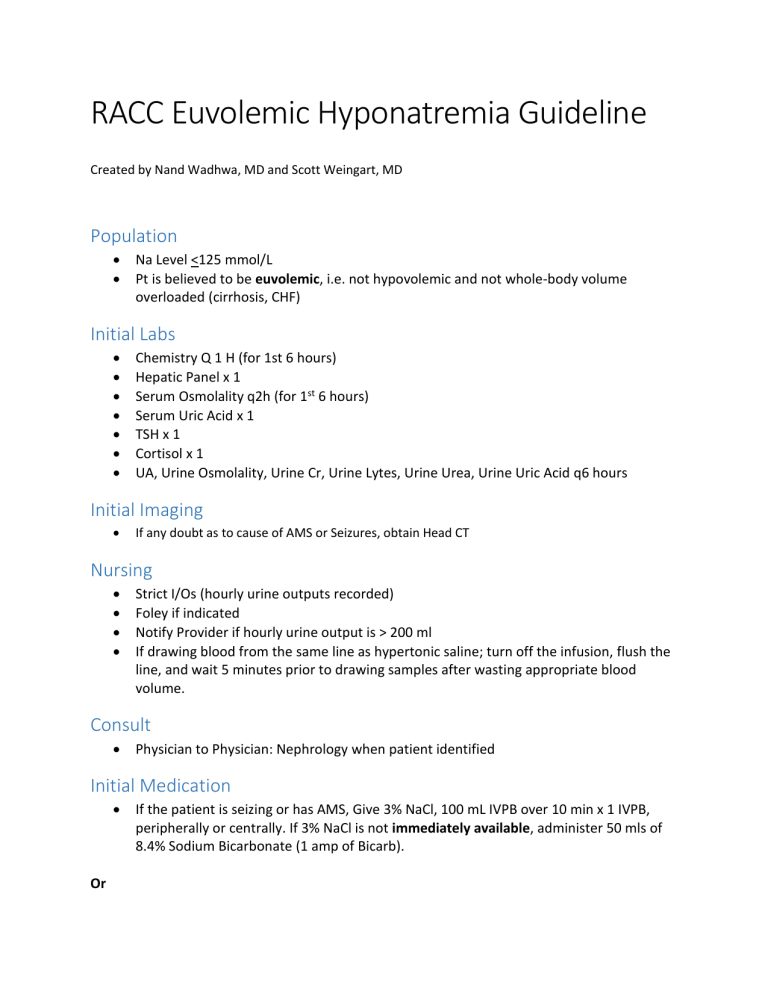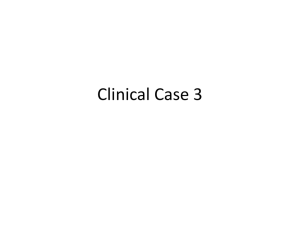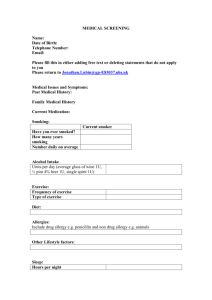RACC Euvolemic Hyponatremia Guideline

RACC Euvolemic Hyponatremia Guideline
Created by Nand Wadhwa, MD and Scott Weingart, MD
Population
Na Level <125 mmol/L
Pt is believed to be euvolemic, i.e. not hypovolemic and not whole-body volume overloaded (cirrhosis, CHF)
Initial Labs
Chemistry Q 1 H (for 1st 6 hours)
Hepatic Panel x 1
Serum Osmolality q2h (for 1 st 6 hours)
Serum Uric Acid x 1
TSH x 1
Cortisol x 1
UA, Urine Osmolality, Urine Cr, Urine Lytes, Urine Urea, Urine Uric Acid q6 hours
Initial Imaging
If any doubt as to cause of AMS or Seizures, obtain Head CT
Nursing
Strict I/Os (hourly urine outputs recorded)
Foley if indicated
Notify Provider if hourly urine output is > 200 ml
If drawing blood from the same line as hypertonic saline; turn off the infusion, flush the line, and wait 5 minutes prior to drawing samples after wasting appropriate blood volume.
Consult
Physician to Physician: Nephrology when patient identified
Initial Medication
If the patient is seizing or has AMS, Give 3% NaCl, 100 mL IVPB over 10 min x 1 IVPB, peripherally or centrally. If 3% NaCl is not immediately available, administer 50 mls of
8.4% Sodium Bicarbonate (1 amp of Bicarb).
Or
In neurologically stable patients, Give 3% NaCl, 100 mL IVPB over 20 min x1 IVPB, peripherally or centrally
And simultaneously
dDAVP 2 mcg IV Stat and Q6 hrs x 4 doses
Assessment after 1
st
dose of Hypertonic Saline
If 1-hour Na level < 3 mmol/L increase, give second dose of 3% NaCl 100 mL over 20 min x1 and continue to check Chem 8 Q1H for up to 6 hours;
If 1-hour Na level >3 mmol/L increase, DO NOT GIVE Additional 3% NaCl
Send repeat chemistry
Assessment after 2
nd
dose of Hypertonic Saline, if Given
If repeat Na level < 3 mmol/L from initial sodium, give third dose of 3% NaCl 100 mL over 20 min x1
If repeat Na level >3 mmol/L from initial sodium, DO NOT GIVE 3% NaCl
Goal is to achieve 3-6 mmol/L increase in Na in the 1 st 6 hours
Goal is to increase sodium by no more than 6mmol/L in the 1 st 24 hours
Continued Management
Plan is to keep patient in the RACC for the first 4-6 hours. Based on patient response and labs, decide on site of admission
Beware of simultaneous repletion of potassium as this will increase the serum sodium
Expect urine outputs of <30-40 ml/hr while on dDAVP protocol
Overshoot
If increase more than 6 mmol/L over 1 st 24 hours:
DDAVP 2 mcg IV X1 and then q 6hrs (only if not already administered)
Administer D5W over 15 minutes. Amount required is calculated based on total body water needed to decrease Na back to ≤ 6 mmol/L from baseline
Mls of D5W = 600 [weight kg] [(Current Na/Desired Na) – 1]
Be aware, potassium supplementation will increase sodium levels
Admission:
MICU – If symptomatic and/or Na sig. < 125. Place central line and foley catheter
Medical Floor-If asymptomatic with Na near to 125, admit to Medical floor
Formulas/Calculators:
Predicted Sodium Calculator-Adrogue-Madias Formula
Change SNa in mmol/L by 100 ml of 3% NaCl = (51.3 mmol + K mmol ) / TBW + 100
TBW Calculator Watson formula
Male: 2.447 - (0.09516 X age [years]) + (0.1074 X height [cm]) + (0.3362 X weight [kg])
Female: -2.097 + (0.1069 X height [cm]) + (0.2466 X weight [kg])
Continued Orders
MICU – If symptomatic and/ or an increase more than 6 mmol/L in 6 hrs, Chem 8 q 2hr, serum osmolality every 4 hr, urine lytes and osmolality every 4 hr X first 24 hrs
MEDICAL FLOOR – Chem 8 q 4hr, serum osmolality every 6 hr, urine lytes and osmolality every 6 hr X first 24 hrs. Goal: increase no more than 6 mmol/L in 24 hrs; no further rise if already achieved in 6 hrs. Water intake to minimum, Regular diet with no salt restriction




